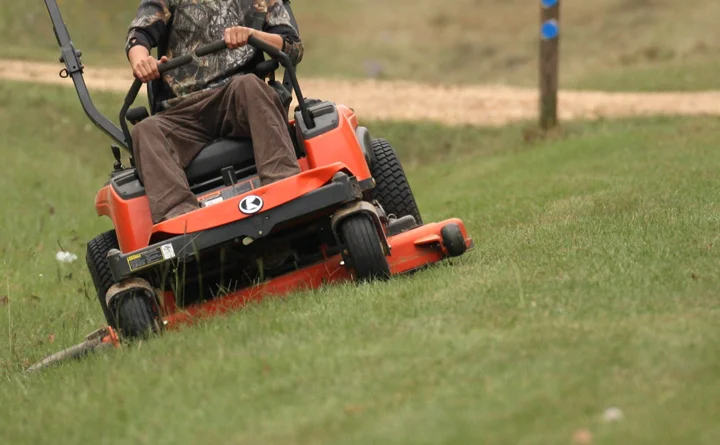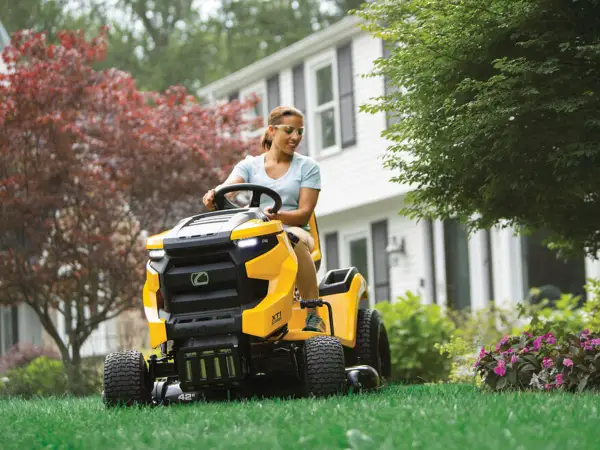Zero-Turn Mower Dangers (Plus Safety Advice!)
Using a zero-turn mower, you can quickly and efficiently mow your entire lawn. The risks of using this lawn equipment should be carefully considered before you start the engine and begin cutting the grass.
Zero-turn mowers are undeniably effective and simple to use, but they carry serious risks if used carelessly. Incorrect use could result in mishaps that could have been avoided with some forethought on the part of the operator.
Some of these potential dangers will be discussed, along with helpful advice for avoiding them and having a productive mowing experience. Our goal here is not to dissuade you from using this incredible tool, but to inform you of the risks involved and how they can be mitigated.
Let’s take a look at these threats and figure out how to deal with them wisely.
Table of Contents
Rollover Danger
A zero-turn mower’s superior stability is the result of its low center of gravity. One of the reasons they have gained in popularity among both homeowners and landscape architects is their novel design.
However, these vehicles can still roll over, even with their improved stability, especially while operating on uneven ground or hills. Any unexpected movement, pause, or loss of control might cause a potentially disastrous tip.
The danger of a rollover disaster is not restricted to novice drivers; even experts can get themselves into a sticky situation if they aren’t careful.

Safety Advice 1: Be Wary of Hills and Slopes
Be careful when driving up and down hills and slopes with a zero-turn mower. Despite the mower’s low center of gravity, navigating uneven ground can be difficult.
To reduce potential danger, approach slopes cautiously. On a hill, the risks increase if you move or stop suddenly.
Equally important is to steer clear of sudden twists uphill. Wider, more progressive spins will help keep your mower from tipping over.
Zero-turn mowers can swiftly shift directions, but their design poses risks when operating on terrain with large variations in level.
Using a walk-behind mower is recommended for locations with steep slopes or difficult terrain. Mowers that the operator walks behind are typically more maneuverable and suitable for use in such conditions.
Safety Advice 2: Constantly exercise control
Operating a zero-turn mower requires constant attention and focus to ensure a safe and efficient mowing experience. One crucial aspect of this is maintaining control over the machine at all times. To do so, always keep both hands on the steering levers. It will provide the necessary stability and precision while navigating your lawn.
Also, avoid making sudden movements, such as taking sharp turns. While flashy, these maneuvers can destabilize the machine, increasing the risk of accidents and potential rollovers.
Instead, strive for smooth and deliberate movements while steering, accelerating, and decelerating. This approach minimizes risks and might even contribute to a more polished cut for your lawn.
Stay prepared for unexpected situations that may arise while mowing. Whether it’s an unforeseen obstacle or uneven terrain, being able to react calmly and decisively is crucial for maintaining control of your zero-turn mower.
If you lack confidence in this regard, regular practice sessions can help you become more comfortable handling the machine, allowing you to develop quick reflexes and better maneuverability.
Possibility of Ejection
While zero-turn mowers’ open design improves visibility and mobility, it also exposes operators to potential dangers. For instance, in the event of an accident, ejection may occur.
The driver is at risk of serious injury if they are flung from their seat in the case of an accident or a quick loss of control.
If you are ejected from a zero-turn mower, you could potentially be injured by the blades. If these blades make touch with a person’s limbs, it might result in severe injuries or even amputation.
Furthermore, there is the potential for running into rocks, trees, or fences. Bruises, broken bones, and concussions are all possible outcomes of such a collision.
Safety Advice 3: Always use seatbelts.
Seatbelt use is mandatory and should not be taken lightly. This precautionary function is standard on many mowers, and for good reason.
Wearing a seatbelt while operating a mower can greatly reduce injury risk, even in less dramatic scenarios.
Mowing at high speeds or across uneven ground increases the likelihood of encountering an unexpected jolt or bump that could cause you to lose control of the mower. Without a seatbelt, you have a much higher chance of being ejected from the mower, increasing your risk of serious injury or death.
Safety Advice 4: Remain Vigilant and Concentrated
Maintaining vigilance and focus while steering a zero-turn mower is of paramount importance. It entails keeping a vigilant eye out for anything that could cause you to lose control of the vehicle in the immediate vicinity.
Watch alert for things like tree roots, pebbles, and uneven ground that could cause your mower to tip over. Keeping your eyes peeled for these obstructions will let you control your speed and course while avoiding harm.
Keep in mind that fatigue and distractions are two more things that might negatively affect your focus when mowing. If you feel yourself getting fatigued or distracted, it’s important to take a short rest.
Finally, before beginning work, make sure you’ve familiarized yourself with the zero-turn mower’s controls and features. If you know your way around the equipment, you’ll be more prepared to handle any emergencies that may arise.
High-Speed Risks

The zero-turn mower’s exceptional speed capabilities undoubtedly contribute to the machine’s worldwide acclaim. Even the largest lawns are no match for these robust machines, which can easily avoid obstacles while trimming massive areas of grass in a fraction of the time required by manual mowers.
To be sure, a zero-turn mower at high speeds can be a lot of fun to use. The ability to respond swiftly to novel circumstances may also be impaired.
Safety Advice 5: Go slowly
It can be tempting to take advantage of the zero-turn mower’s amazing speed capabilities, but doing so greatly raises the risk of accidents and injuries.
Instead, go at a steady pace that will give you plenty of time to respond to any hazards or obstructions you encounter. If you want more time to make the appropriate decision, slow down as you approach tight spots or turn corners.
Accidents involving pets, children, or other people can be avoided by paying attention to your surroundings and reducing your speed as needed.
Maintaining a relaxed and steady pace when navigating your lawn is essential for your own safety. Enjoy the advantages of your zero-turn mower while limiting the risks involved by achieving a balance between efficiency and caution.
Safety Advice 6: Maintain a Safe Distance from Contours
As the name implies, zero-turn mowers can turn on a dime to avoid bumping into obstacles. However, when in use, it is essential to keep a safe distance from obstacles like trees, fences, and buildings. You can avoid crashes and save your mower and your property from getting damaged if you give yourself plenty of area to respond and alter course.
As you get closer to an impediment, you should slow down and take stock of the situation. Find the minimum distance you need to keep your mower under control as you move around the obstacle. Keep at least the width of your mower between your machine and the obstruction to ensure safe operation.
Keep an eye out for obstacles in your mowing route, such as low-hanging branches or projecting roots. If you want to prevent getting trapped or wrecking your mower, you’ll need to exercise extreme caution around these obstacles.
Debris Threats
It’s normal for yard waste to be flung at great speeds when you mow the grass. These projectiles should be treated as potentially lethal; they have caused harm and damage to property on more than one occasion. This danger is amplified by a zero-turn mower’s strong blades and fast speed capabilities.
The area around the mower isn’t the only thing that might be damaged by flying debris; it can affect areas many feet away as well. As a result, kids playing nearby or parked cars in the area can get hit by one of these fast moving projectiles.

Safety Advice 7: Remove All Trash Before Mowing
Before you start mowing, it’s important to take a good look around the area. Take a stroll around the perimeter of your property to check for any obvious debris or obstructions.
Sticks and branches may have fallen or be hidden in locations near trees or shrubs, so extra caution should be exercised in those spots. Don’t forget to inspect under and behind any yard or patio decor, since this is a common spot for things to be forgotten or left behind.
After you’ve located any possible dangers on your lawn, it’s important to get rid of them. You can quickly get the area ready for mowing by picking up small rocks and sticks by hand, or by using a rake or leaf blower to clear bigger areas.
Keep a mental note of the locations of larger objects like tree stumps or rocks that can’t be moved so you can mow around them.
Safety Advice 8: Be Aware of Your Environment
In order to keep yourself and people around you safe when operating a powerful zero-turn mower, you need to maintain a high level of awareness at all times. Always be aware of your surroundings and keep an eye out for people, animals, and other obstacles when mowing.
Setting up a “safety zone” around your mowing area is one approach to ensure everyone’s safety. Tell people in the area that you’ll be mowing so that they can keep their kids and pets out of the way. This additional safety measure can lessen the likelihood of accidents and injuries to others.
Keep an eye out for anything on the lawn that could cause you harm, including people and animals. Keep an eye out for toys, hoses, and other anything that could be hiding in the grass. If the mower’s blades hit one of these items, it could become a dangerous missile.
Be cautious as you navigate the zero-turn mower. Do not use your phone or listen to music that could interfere with your ability to respond swiftly in the event of an emergency.
Maintaining a sharp awareness of potential threats and keeping your attention on the task at hand will make your lawn care routine safer for everyone.
Mistakes in Maintenance
If you want to keep your zero-turn mower in top shape, regular maintenance is a must.
A well-maintained mower will cut through the grass like butter, speeding through even the toughest areas. However, your zero-turn mower’s efficiency will suffer greatly if you skip regular maintenance.
As parts age, they become more prone to malfunctions, and eventually fail if no maintenance is performed in a timely manner. As a result, your capacity to keep your lawn or property in good condition will diminish along with your efficiency.
In addition, the danger of accidents and injuries rises when a mower isn’t properly maintained. It’s more probable that something will go wrong with your system the longer you wait to solve any problems it may be having.
Safety Advice 9: Frequently Check Your Mower
Regular inspections are one of the best ways to ensure your safety when operating a zero-turn mower. You may prevent any problems that might endanger your machine’s safe operation by giving it a complete examination.
Make sure there are no worn belts, loose nuts, or other issues that could threaten the machine’s safety or performance. If you find any symptoms of wear or damage, such as loose bolts or dull blades, you should take immediate action to rectify the situation.
Check the tires, the steering, and the controls as well, as they are all crucial to the operation of your mower. Verify that everything is in working order and free of damage or wear. In this approach, you can prevent potential threats to your safety from developing into major ones.
Safety Advice 10: Observe the manufacturer’s instructions for upkeep and repairs.
Adherence to the manufacturer’s instructions is another crucial aspect of maintenance. Following these rules will help ensure that your system continues to function properly and safely over time.
All forms of maintenance, from oil changes and spark plug replacements to air filter cleanings, should be performed according to these guidelines.
Oil changes are a crucial part of preventative maintenance. Maintaining proper engine lubrication on your lawn mower is just as important as doing so on your car. Change the oil at the intervals and with the type of oil advised in the owner’s handbook.
Keep tire maintenance in mind, as well. Better traction and stability when mowing can be achieved through routine tire pressure checks and maintenance.
Conclusion
Lawn maintenance can be a breeze with the help of a zero-turn mower. But they aren’t completely risk-free either. The same safety considerations that apply to any high-performance equipment also apply to these devices.
Keeping your lawn care routine risk-free can be accomplished through regular upkeep, following the manufacturer’s requirements for maintenance and repairs, and engaging in safe mowing techniques. Finding a happy medium between speed and prudence is essential for safe mower operation.
You may confidently take on your yard work without jeopardizing your health if you take the time to learn about the potential dangers linked with zero-turn mowers and carefully adhere to our suggested safety tips.
Jack, enamored with the sport, attended THE Ohio State University to earn a degree in Golf Course Management. He was able to work on some of the most prestigious courses in the country thanks to his choice of profession.Jack’s side business, Inside The Yard, took off thanks to the pandemic and eventually replaced his primary source of income. Jack and his family have moved to a farm in Central Arkansas since he founded the company. There, they grow cattle and two young daughters.








